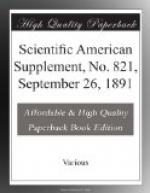On development, say for one, two, or three minutes, wash off and fix. You will recognize the H violet lines and the others to the left, and this experiment shows what is the sensitiveness of this particular plate to the various regions of the spectrum with this particular apparatus, and with a normal exposure and development. So far, this teaches very little; it merely indicates that this particular plate is sensitive or insensitive to certain rays of colored light. To make this teaching of any value, we must institute comparisons. Accordingly, instead of simply exposing one plate, suppose we cut a strip from two, three, four, or even half a dozen different plates, and arrange them side by side, horizontally, in the dark slide, so that the spectrum falls upon the whole when they are placed in the camera and exposed. There is really no difficulty in cutting strips a quarter of an inch wide, the lengthway of a quarter plate. Lay the gelatine plate film up, and hold a straight edge on it firmly, so that when we use a suitable diamond we can plow through the film and cut a strip which will break off easily between the thumb and finger. A quarter plate can thus be cut up into strips to yield about a dozen comparative experiments. When cut and snapped off, mark each with pencil with such a distinguishing mark as shall be clearly seen after fixing. The cut up strips can be kept in the maker’s plate box.
* * * * *
The deep down underground electric railway in London has so far proved an unprofitable concern for its stockholders. It is 31/2 miles long, touches some of the greatest points of traffic, but somehow or other people won’t patronize it. The total receipts for the last six months were a little under $100,000, and they only carried seventeen persons per train mile. On this road the passengers are carried on elevators up and down from the street level to the cars. The poor results so far make the stockholders sick of the project of extending the road.
* * * * *
A NEW CATALOGUE OF VALUE
Contained in Scientific American Supplement during the past ten years, sent free of charge to any address. Munn & Co., 361 Broadway, New York.
* * * * *
THE SCIENTIFIC AMERICAN
ARCHITECTS AND BUILDERS EDITION
$2.50 a Year. Single Copies, 25 cts.
This is a Special Edition of the Scientific American, issued monthly—on the first day of the month. Each number contains about forty large quarto pages, equal to about two hundred ordinary book pages, forming, practically, a large and splendid Magazine of Architecture, richly adorned with elegant plates in colors and with fine engravings, illustrating the most interesting examples of modern Architectural Construction and allied subjects.




